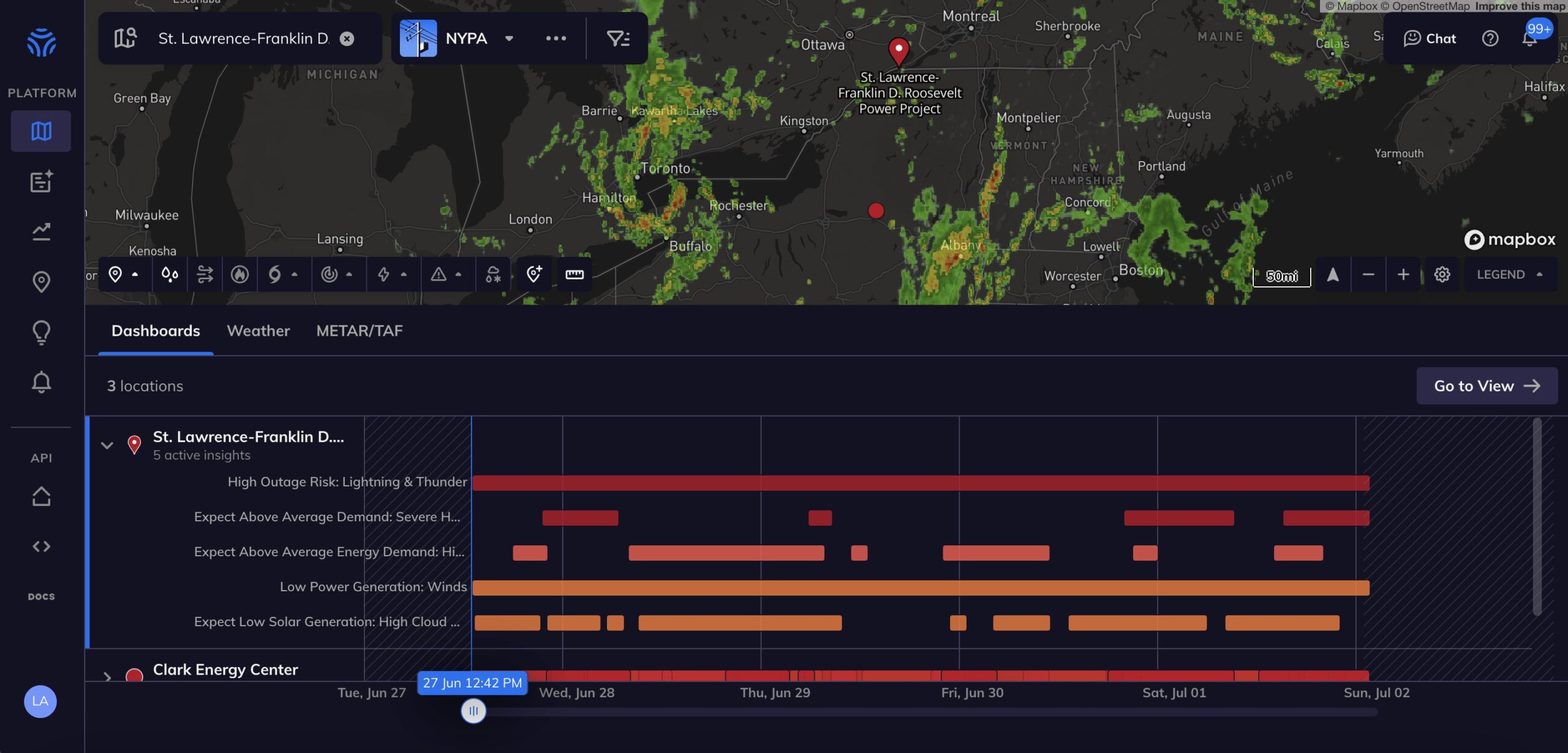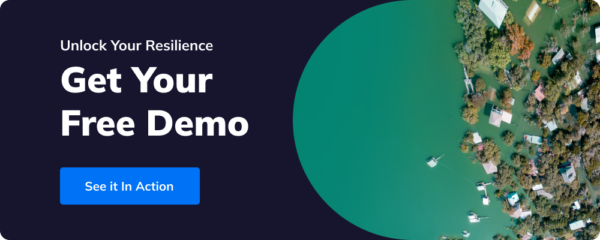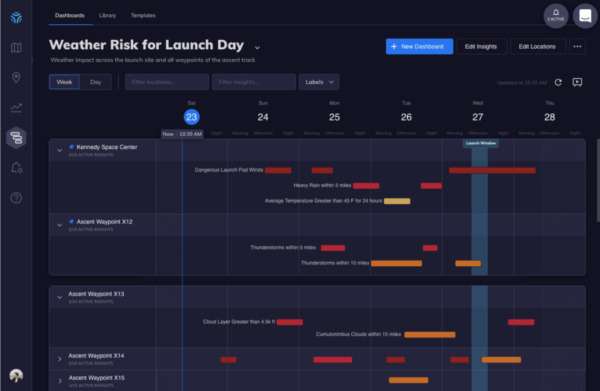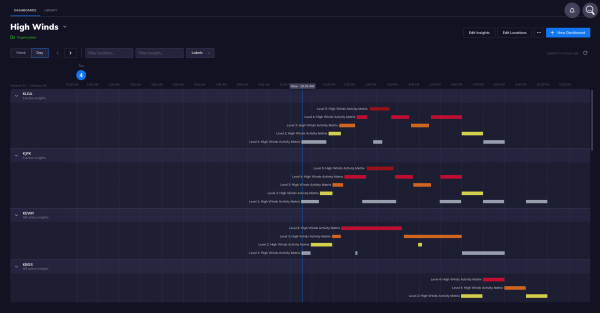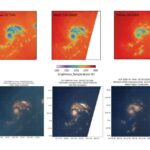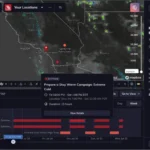Whether it’s an approaching hurricane or incoming wildfire smoke, early warning systems (EWS) are indispensable in giving us the time and information necessary to prepare for imminent danger.
This comprehensive guide delves into the ever-critical subject of EWS, equipping you with knowledge on the different components of an early wearing system, their benefits, challenges, and the latest technologies employed in these life-saving systems.
So, let’s embrace our innate human curiosity and explore how we can become better protected against unpredictable forces by understanding and utilizing early warning services.
What Is An Early Warnings System?
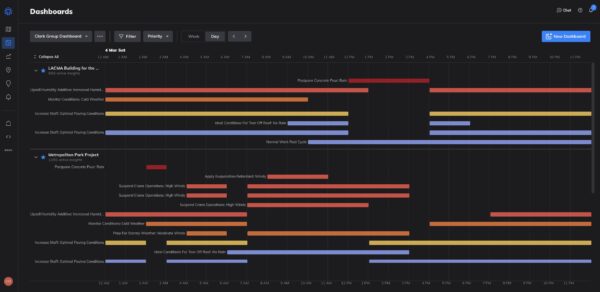
Tomorrow.io’s Insights Dashboard and Early Warnings
Early warning systems refer to networks that monitor specific triggers or risks round-the-clock and prompt authorities, communities, and businesses with vital information when a potential threat is detected. These sophisticated arrangements provide an adequate lead time for affected parties to take preventive measures or respond effectively before calamity strikes.
The premise of EWS revolves around mitigating adverse impacts by harnessing data via tracking mechanisms and translating them into actionable insights for proper disaster management.
Ranging from weather-related natural catastrophes like cyclones to man-made hazards such as chemical leaks, early warning systems are widely adopted across a variety of domains. They play a pivotal role in safeguarding people’s lives, property, assets, national security, and economies – everything at risk during unforeseen adverse events.
Moreover, early warning systems actively foster disaster resilience within sectors like agriculture government, and public health.
The United Nations Office for Disaster Risk Reduction (UNDRR) defines an early warning system as “an integrated system of hazard monitoring, forecasting, and prediction, disaster risk assessment, communication and preparedness activities systems and processes that enable individuals, communities, governments, businesses, and others to take timely action to reduce disaster risks in advance of hazardous events.”
In essence, early warning systems not only help save lives but also foster socio-economic development through risk reduction strategies tailored towards securing sustainable growth even during challenging times – which makes examining them all the more crucial.
What Types of Early Warning Systems Are There?
There are various types of early warning systems (EWS) globally, catering to different needs, as well as various components that affect early warnings. EWS can be categorized based on the types of hazards they monitor, their operational levels, or whether they are designed for single or multiple hazards.
Regardless, of their category, early warning systems (EWS) are vital tools designed to help individuals, organizations, and governments prepare for and mitigate the impacts of natural disasters, environmental hazards, and other potential crises.
The ability to detect threats in real-time allows for swift action that can save lives and reduce damages.
Early warning systems have even been included in worldwide climate action plans and have been recognized by the disaster management community. The Paris Agreement, signed in 2015, acknowledges that EWS is an area around which we must facilitate better understanding and create plans around. The Sendai Framework for Disaster Risk Reduction (2015-2030) also highlights and explicitly mentions the need to enhance disaster preparedness for effective response.
To better understand the diversity among these systems, let us review several prominent categories and the components that contribute to them.
Components of an EWS
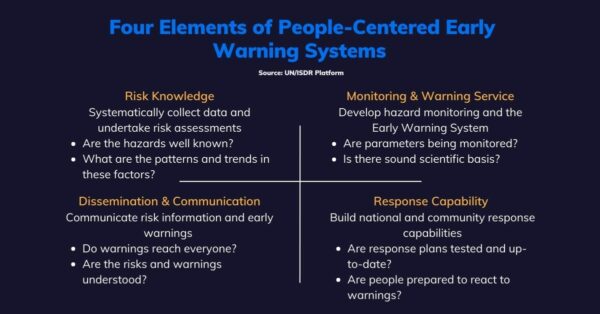
Early on in the disaster risk conversation, experts introduced four concepts of efficient early warning systems based on four different elements:
- Disaster risk knowledge based on the systematic collection of data and disaster risk assessments
- Detection, monitoring, analysis, and forecasting of the hazards and possible consequences
- Dissemination and communication, by an official source, of authoritative, timely, accurate, and actionable warnings and associated information on the likelihood and impact
- Preparedness at all levels to respond to the warnings received
As time has gone on, the concept of a multi-hazard warning system has also been promoted. Multi-hazard systems address the impact of multiple types of hazardous events, which we’ll discuss more shortly.
Early Warning Systems By Hazard Type
Meteorological Early Warning Systems
Meteorological early warning systems typically focus on predicting weather-related events like hurricanes, cyclones, tornadoes, blizzards, or floods.
They typically employ satellite images, Doppler radar technology, and ground-based sensors to gather data about developing storm systems. Meteorological EWS serve two main purposes:
- Giving the public sufficient time to take precautionary measures before an impending disaster.
- Providing essential information to governmental agencies responsible for coordinating emergency responses.
Technology in this space includes Tomorrow.io’s global early warning system product for cities and countries, which helps governments better prepare for, mitigate, and adapt to the ever-growing number of climate-related challenges. This same technology is about to be enhanced by the company’s upcoming constellation of historic weather radar satellites , which will ultimately improve EWs for precipitation-type high-impact weather events.
See Tomorrow.io’s Global Early Warning System Product Today
Geological Early Warning Systems
In contrast to meteorological systems which deal with atmospheric phenomena, geological early warnings monitor natural disasters like earthquakes, tsunamis, volcanic eruptions, and landslides. Seismic monitoring stations play a crucial role in these systems by detecting tremors from underground tectonic activities.
Advanced technologies such as global navigation satellite systems (GNSS) are also used to measure crustal deformations in real-time accurately. Once the collected data suggests an imminent threat, authorities can disseminate warnings accordingly.
Hydrological Early Warning Systems
Closely related to meteorological EWS but focusing specifically on water-based hazards are hydrological early warning systems. In areas prone to potentially disastrous floods or water-related calamities, hydrological early warning systems prove invaluable. These EWS monitor bodies of water continuously tracking variables like water levels, rainfall amounts, soil moisture content, and snowmelt rates. If these factors indicate flood risks or other dangers exceeding predetermined limits within a certain geographical range, alarms trigger so that affected populations receive alerts promptly.
Enhancements like Tomorrow.io’s Flood Risk Index further bolster these systems by predicting flood risks up to five days in advance worldwide. A striking example was during Hurricane Ida in 2021, when the index identified significant flood risks in the Northeast U.S. a full 48 hours before any official warnings were issued.
Start Getting Early Flood Risks Today
Environmental Early Warning Systems
To address environmental concerns such as pollution levels or deforestation progressions in real time come environmental early warning services. These types of EWS encompass air quality monitoring sensors that evaluate pollen count levels or alert citizens when harmful substances exceed set thresholds in their surroundings.
Health and Epidemic Early Warning Systems
Keeping a pulse on public health matters is a top priority, especially amid global pandemics. Early warning systems focused on health and epidemics enable timely detection of emerging diseases through continuous surveillance of data from hospitals, emergency rooms, primary care providers, and other pertinent sources. Syndromic surveillance, for example, detects trends in the symptoms that people report when seeking medical help, serving as essential early warnings for potential outbreaks or changes in disease transmission patterns.
In summary, early warning systems encompass various domains to detect potential threats quickly and notify communities at risk. Implementing these solutions is vital to ensure adequate preparedness for disastrous events.
Tomorrow.io’s Early Warning System
Understanding the various types of early warning systems available helps industries, governments, and individuals make effective decisions when it comes to disaster preparedness and response.
Tomorrow.io offers a weather and climate security platform that combines the various types of weather, environmental, and maritime-related events insights and impacts in one single location so you can better prepare, understand, and act on high impact and severe weather events.
These tailored solutions offer a vital advantage in rapidly evolving situations and form a cornerstone in safeguarding lives, livelihoods, and resources from adverse unforeseen events.
What is the Difference Between Single-Hazard EWS and Multi-Hazard Early Warning Systems?
When it comes to disaster preparedness, both Single-Hazard Early Warning Systems and Multi-Hazard Systems play pivotal roles.
Single-Hazard Early Warning Systems are tailored to address a specific type of threat such as a single cyclone, earthquake, or chemical leak. These systems focus on in-depth and specialized monitoring of their respective hazards, providing precise and detailed data that is crucial for comprehensive risk assessment and management.
On the other hand, Multi-Hazard Systems are designed with a more holistic approach, capable of monitoring and alerting communities about multiple hazards simultaneously. They factor in the interconnectedness of various threats, recognizing that one type of disaster can often trigger another. For instance, an earthquake can lead to tsunamis and landslides, and a comprehensive Multi-Hazard System will be equipped to monitor and alert for all these events concurrently.
Today we are marked by increasing environmental volatility and interconnected risks, Multi-Hazard Systems offer a broader protective net. Yet, the specialized focus of Single Hazard Systems remains invaluable for high-risk areas where specific threats pose an elevated risk. Ultimately, the system you choose depends on the unique context and risk landscape of each community or organization.
What Are The Benefits of Early Warning Systems?
The benefits of EWS are numerous and significant.
First and foremost, is their ability to save lives by providing communities with ample time to evacuate or take necessary precautions. Advanced EWS can predict catastrophic events like hurricanes, tsunamis, volcanic eruptions, and earthquakes with increasing accuracy.
“Early warning systems are crucial in reducing risks from extreme weather events like storms, hurricanes, and floods. These systems help ensure public safety by warning people in advance about dangerous weather conditions, allowing them to take precautions, find shelter, or move to safer areas.
They also play a vital role in adapting to global climate change, providing insights into changing weather patterns and helping communities develop strategies to protect infrastructure and mitigate climate impacts.” – Mckenzie Bowden, Government Business Solutions Engineer at Tomorrow.io.
These systems have become so prominent that earlier this year, the World Meteorological Organization and the United Nations unveiled an ambitious goal to provide everyone on Earth with EWS in the next five years. By 2030, everyone on Earth should be protected by early warning systems against increasingly extreme weather and climate change.
According to UN Secretary-General António Guterres,
“Human-caused climate disruption is now damaging every region. The most recent report of the Intergovernmental Panel on Climate Change details the suffering already happening. Each increment of global heating will further increase the frequency and intensity of extreme weather events.”
By providing people, businesses, and governments with more notice, we can better prepare ourselves for the impact of severe weather events. As a result, these timely warnings minimize the loss of human life while reducing economic losses caused by property damage.
Enhanced Planning and Preparedness
A key benefit associated with early warning systems is that they contribute significantly towards improving overall disaster preparedness for both policymakers and citizens.
Detailed information furnished by EWS allows decision-makers at different levels – from local authorities to national governments –to plan effectively during emergency situations. This could include devising safer evacuation routes or distributing resources where they are needed most.
Encouraging Sustainable Development
Implementing an EWS promotes sustainable development practices across several industries as stakeholders in these areas work together to invest in resilient infrastructure that withstands potential threats posed by natural disasters or other emergencies. This joint effort helps ensure that regions can bounce back faster after being hit by catastrophes while mitigating long-term negative effects on the economy.
- Better Resource Allocation
- Facilitating Climate Change Adaptation
- Empowering Communities
Challenges of Early Warning Systems
Implementing effective early warning systems (EWS) faces numerous challenges. While these systems have the potential to save lives and reduce damages resulting from natural disasters, their impact can be hindered by various factors. In this section, we will delve into some of the main obstacles that may stand in the way of EWS implementation or its maximization.
Data Collection and Management
One of the primary challenges for an early warning system is data collection and management. Earth observation technologies are advancing at a rapid pace; however, obtaining accurate information on all relevant parameters remains a difficult task. Moreover, managing vast amounts of collected data calls for efficient algorithms and analysis tools to generate timely and actionable insights.
- Insufficient monitoring networks: The efficiency of an EWS largely depends on its capacity to collect precise data about environmental changes. Inadequate or poorly maintained monitoring stations can lead to inaccurate predictions.
- Remote locations: Monitoring devices often need to be installed in remote areas with limited access, increasing installation and maintenance costs.
- Data integrity: Ensuring data reliability requires robust quality control measures throughout the entire information chain.
Communication Barriers
Another significant challenge lies in communicating early warnings effectively. To avoid panic or confusion during a crisis situation, it is essential that everyone understands what actions they should take upon receiving an alert.
- Language barriers: Disseminating clear messages across diverse communities requires accurate translation using language-appropriate terminology.
- Technical jargon: Simplifying complex scientific concepts without compromising accuracy allows for better comprehension among non-specialist recipients.
- Accessibility: Making sure vulnerable groups such as those with disabilities receive timely alerts may entail creating tailored communication channels.
Response Capacity and Coordination
The effectiveness of an EWS does not solely depend on issuing alerts, but also on how well communities respond once they receive them. This involves coordinating with stakeholders at multiple levels—from government entities to local populations—ensuring sound response planning and training, as well as the ability to update plans based on evolving scenarios.
- Lack of funding: Adequate resources are essential for building resilient infrastructure and maintaining operations throughout emergencies.
- Training gaps: Regular training should be conducted to educate communities on how to react appropriately in various disaster situations. Effective EWS integration into local response protocols is paramount.
Public Compliance
Lastly, early warning systems can only be truly effective if people understand and trust them. Gaining public confidence in EWS necessitates ongoing efforts aimed at familiarizing individuals with the system’s objectives and mechanics.
- Awareness campaigns: Systematic outreach activities can help foster a culture of preparedness among communities, making them more inclined to follow alerts diligently.
- Addressing skepticism: Ensuring data transparency and regularly sharing updates about the improvement of early warning technologies may help assuage doubts about their reliability.
Overcoming these challenges demands continued investment not only in EWS technology but also an effective collaboration between governments, research institutions, frontline responders, NGOs, meteorological agencies, and affected communities.
With time, and emerging weather radar constellations, both national and international efforts have the potential to deliver robust early warning systems that could minimize the impacts of natural disasters worldwide.
What Technologies Are Used in Early Warning Systems?
In order to effectively provide early warnings to communities at risk, various technologies are utilized by early warning systems (EWS). These cutting-edge innovations enable the rapid collection and interpretation of crucial data for predicting disasters and mitigating their effects. These technologies also have the power to improve global forecasting capabilities. Tomorrow.io’s first-of-its-kind, commercial weather satellite constellation is equipped with radars and microwave sounders that is enhancing our current systems with better weather data for forecasting.
As technology advances, the effectiveness of these systems continues to improve. In this section, we will explore some key technologies that drive today’s state-of-the-art EWS.
Remote Sensing
Among the essential methods used for collecting information about potential hazards is remote sensing technology. Remote sensors, such as satellites and drones, can gather critical data on weather patterns and natural phenomena from a safe distance. This information aids in determining the severity of an event and assists decision-makers with formulating timely responses.
Some of the primary advantages that remote sensing offers include:
- Continuous monitoring: Satellites operate 24/7, providing near real-time tracking of weather conditions and environmental changes.
- Wide coverage: Satellites can monitor vast regions, often capturing data from multiple countries simultaneously.
- High-resolution data: The latest satellite imagery features incredible detail, making it possible to detect even subtle variations in climatic variables.
Weather Radars
Weather radars are another fundamental component of many early warning systems. By emitting radio waves that bounce off objects like raindrops or snowflakes, these high-frequency radar systems can provide detailed insights into precipitation levels and storm movements. Meteorologists use this information to forecast severe weather events such as thunderstorms, tornadoes, or heavy rainfall accurately.
Notably, advancements in dual-polarization radar technology have further improved precipitation measurements’ accuracy by distinguishing between raindrop shapes. Consequently, meteorologists can better predict potential flooding issues based on more reliable data.
Communication Networks
Efficient communication channels are crucial for disseminating early warning system alerts to impacted populations promptly. Various modes play a part in delivering these messages; some examples include:
- Television and Radio: Traditional mass media can rapidly broadcast warnings, making them accessible to a vast audience.
- Cellphones and SMS: With the widespread use of mobile phones, text messages can deliver personalized notifications directly to at-risk individuals.
- Mobile Applications: Smartphone apps provide real-time updates on weather conditions and immediate alerts as users remain connected to the internet.
- Social Media Platforms: Warnings shared through social media networks can reach extensive audiences quickly.
Artificial Intelligence (AI) and Machine Learning
In recent years, artificial intelligence has played an increasingly significant role in enhancing early warning systems’ effectiveness. By harnessing machine learning algorithms, early warning systems can analyze large volumes of historical and current data for predicting events with greater accuracy as well as use AI such as Tomorrow.io’s weather AI Gale, to provide weather insights that will help aid in weather forecasting and preparedness. AI technology, such as that from Tomorrow.io, offers:
- Enhanced pattern recognition capabilities
- Rapid processing of complex data sets
- Continuous improvement over time as models learn from new information
- Increased reliability in forecasts and predictions
- Upcoming proprietary weather data from space
Collaborating with advanced technologies in remote sensing, weather radars, communication networks, and AI-powered analysis tools have allowed early warning services to become more reliable than ever before. As a result, communities around the world are better equipped to prepare for and minimize the risks associated with natural disasters or extreme weather events.
Learn more about Gale, Tomorrow.io’s Weather & Climate Generative AI
The Future of EWS with Tomorrow.io’s Space Data
The future of early warning systems (EWS) is witnessing exciting transformations with the incorporation of advanced space data. Tomorrow.io, already a pioneer in delivering robust EWS via its weather intelligence and climate adaptation platform, is taking significant strides in further revolutionizing this field.
The company is on a mission to bring better weather data to the world and this year launched the world’s first and second commercially built weather-radar satellites, Tomorrow-R1 and Tomorrow-R2. These satellites are now orbiting at 500 km above Earth in a polar orbit, and carrying a Ka-band radar ideally suited for detecting precipitation and critical ocean parameters.
R1 and R2 are paving the way for Tomorrow.io’s constellation of more than 20 wide-swathing precipitation radar satellites that will feed Tomorrow.io’s weather and climate security platform to bring businesses and governments better weather data, in real-time on an hourly revisit basis. Prior to launching the R1 and R2 satellites, the only precipitation radar-equipped satellite in orbit was NASA’s GPM Satellite. These satellites will deliver initial samples of what would be the world’s richest and most comprehensive precipitation dataset directly into Tomorrow.io’s observation and modeling functions.
Building on Tomorrow.io’s established EWS, these advancements promise to significantly enhance EWS processes, planning, and risk mitigation. The integration of space data signifies the future of early warning systems, enabling more precise, timely, and actionable warnings for businesses, governments, and communities worldwide.
Summary
In the face of increasing natural disasters and threats to vulnerable communities, early warning systems (EWS) have emerged as critical tools for enhancing preparedness. Different types of EWS cater to diverse hazards such as meteorological events, geological occurrences, and even man-made crises. By utilizing advanced technologies and integrating interdisciplinary knowledge, early warning systems can significantly mitigate risks associated with various disasters and their impact on critical infrastructure.
Despite their challenges, early warning systems offer invaluable protection against unforeseeable dangers while empowering individuals and communities alike in reducing vulnerability. It is crucial for researchers, policymakers, non-governmental organizations, and private sector stakeholders alike to work together in advancing the effectiveness of these systems—in doing so; we take essential steps toward ensuring a safer future for everyone on our planet.
This is where Tomorrow.io shines. Through ongoing innovation and commitment, Tomorrow.io is actively shaping the future of EWS. Alongside our existing weather intelligence and climate adaptation platform, we’re on a mission to revolutionize the way we prepare for high-impact and severe weather events by improving data quality, enhancing predictive capabilities, and fostering a more proactive approach.
Equip yourself with Tomorrow.io’s robust weather intelligence platform, and take a crucial step towards a safer, more resilient future today.
Interested in learning more?
